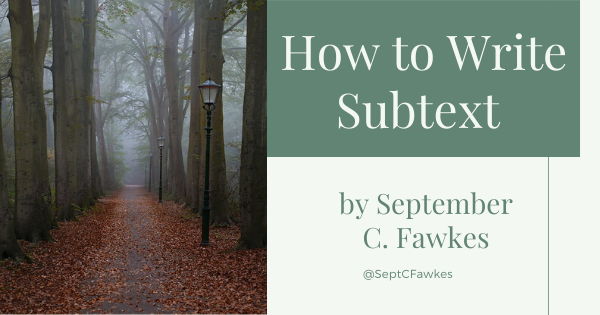
By September C. Fawkes, @ SeptCFawkes
What it is:
Subtext can be a tricky topic to nail down. It often feels elusive, undefined, and sometimes something that “just happens.” But it’s also one of the most effective writing skills to develop.
Subtext is everything that is conveyed to the audience but not stated directly on the page. It’s what is not said. The “sub” in “subtext,” implies that it’s “underneath” the text itself—like reading between the lines, so to speak.
Here is an example of subtext:
Robert, not bothering to raise his hand, spouted out an inappropriate joke.
“Robert, I don’t want to hear that kind of language in my class,” Mr. Henderson said, but the ends of his lips twitched up. “That’s very offensive.” He failed to suppress a full-blown grin.
Here, we can tell that the teacher found whatever Robert said funny, but neither he nor the narrator comes out and tells the reader that. Instead it’s implied by his body language and behavior–what he doesn’t say. What Mr. Henderson actually says to Robert is at odds with how Mr. Henderson acts.
Chances are that this example is a lot more interesting and entertaining than one where Mr. Henderson was being straightforward.
Why Use Subtext?
One of the most powerful things about subtext is that it draws the audience in by inviting them to be a participator of the story, not just a spectator. While spectating a story may be somewhat interesting, participating in one is much more riveting. As writers, we get the audience to participate when we invite them to draw conclusions from the text—about what’s not directly stated.
Subtext is also realistic—it happens in real life all the time. Whether or not we want to admit it, whether or not we are even conscious of it, we all have things we don’t want others to know about us. All of our characters do too. Using subtext makes our characters and story feel more well-rounded and authentic.
Similarly, often when we feel the most intense emotions is when we are most indirect. When we communicate our feelings directly, we lose tension. It’s what is not being said that creates tension. Same goes for your story. Subtext creates anticipation and apprehension, keeping readers interested because of what’s boiling under the surface.
Often you can escalate the subtext to escalate tension.
How it Works and How to Write it
If subtext isn’t on the page itself, then that means it happens within the audience.
But in order for it to happen within the audience, there must be something on the page for them to read more meaning into.
So how do we create that?
Here are some tips and features to help:
Connotations – Some words are charged with powerful connotations, an associated idea or feeling. For example, by dictionary definition, all these words mean essentially the same thing: “stubborn,” “steadfast,” “tenacious,” “strong-willed,” and “ornery.” But they all have different feelings associated with them. Calling someone “ornery” is different than calling someone “steadfast.” How one character describes something can imply their view through subtext.
Implication – If subtext happens within the audience, then that means the text must use implication.
Subtext is a balancing act. That’s one of the reasons why it’s so tricky to master. We need to imply something strong enough for the reader to pick up on, without going overboard or saying it straight out.
So we have to be very careful with our word choices and phrases. We have to have full control over language.
Let’s say we want to show that our character, Jasmine, thinks that our protagonist, Shelly, is incompetent, and we want it to be subtext. We don’t want to come out and say that Jasmine thinks this because it’s more powerful if we imply it.
“You wouldn’t know this, but I don’t do much writing anymore,” Jasmine said. “Those days are over. I use what are called ghost writers, Shelly. People I hire to do the writing for me. I like to sit back and brainstorm a few concepts with a glass of champagne. Do you know what ‘brainstorming’ is?”
“Yes,” Shelly said.
Jasmine simpered. “You’re smarter than I was expecting.”
Jasmine went to Shelly’s bookcase and picked up Elements of Style by William Strunk and E. B. White. “This is one of the best guides to learning how to write,” Jasmine explained to Shelly, though Shelly had read the book five times. “It’s been a bestseller for decades. Did you know that?”
See how phrases and word choices imply that Jasmine thinks Shelly is stupid? See how the question “Do you know what ‘brainstorming’ is?” is like a slap in the face?
That is implication.
Contradictions – Subtext happens when the audience tries to make sense of contradictions, of one sort or another.
In my example above, the context can help set up the contradictions. The audience goes into the scene knowing that both characters are professional writers. And yet, they witness Jasmine talking to Shelly like Shelly knows nothing about the writing industry. Why would Jasmine do that? They are both writers. “Oh,” the audience says (if only on a subconscious level), “because Jasmine thinks Shelly is incompetent, below her.”
The audience finishes the subtext. They draw conclusions from between the lines.
When you put together things that seem to be slight contradictions, it alerts the reader that there must be something more going on here.
Consider my example in the very beginning. What Mr. Henderson says is at odds with what he does—smiles.
It’s helpful to remember that the body doesn’t usually lie. The body language and the inner thoughts of a character trump anything that is said directly—generally speaking (as there are a few exceptions).
Specific Uses
The Unreliable Narrator – Subtext is how writers craft unreliable narrators. It happens when what the narrator says seems to contradict what plays out, cluing the audience in to the fact that this viewpoint may not be completely trustworthy.
“Blind” Characters – You can also use subtext to show when characters are blind (as in ignorant or naive or unaware) to something. They might be blinded by inexperience. They might by blinded by an emotional attachment, like love or admiration. Or maybe they are just a bit dimwitted.
Dramatic Irony – Subtext can be used to create dramatic irony—where the audience gleans something the characters don’t. In some cases, this can lead to powerful revelations for the readers—after all, they are the ones experiencing the revelation, not the characters. It can also further kick up tension.
Humor – Usually the most effective jokes in writing are the ones where the audience finishes the joke themselves. Meaning, the story sets it up, and as the audience makes sense of it, they find the “punch line.”
Tips for Writing Subtext from @SeptCFawkes : Share on X
Sometimes I scare people with my enthusiasm for writing and reading. People may say I need to get a social life. It’d be easier if my fictional one wasn’t so interesting. I have worked in the fiction-writing industry for over eight years and have been editing stories for longer. I have edited for both award-winning and best-selling authors and have worked on manuscripts written for middle grade, young adult, and adult readers. Today I work as a freelance editor, and you can find my editing services here: https://www.fawkesediting.com/ I also run an award-winning writing tip blog: https://www.septembercfawkes.com/
Find me on Facebook: https://www.facebook.com/profile.php?id=100008321732625
Twitter: https://twitter.com/SeptCFawkes
Tumblr: https://septembercfawkes.tumblr.com/
and Instagram: https://www.instagram.com/septcfawkes/
Photo credit: Lenny K Photography on Visualhunt / CC BY
Thanks for the tips on subtext today, September!
Thank you for having me!
I really like the way subtext invites readers to use their imaginations. I think that draws the reader in and makes the reader more likely to engage with the story.
Margot,
Yes, inviting them to use their imaginations–that’s a good way to put it.
Great tips! Subtext is a lot of fun to read and to write! :)